
The Pleurothallidinae are a neotropical subtribe of plants of the orchid family (Orchidaceae) including 29 genera in more than 4000 species.

In the botanical classification of plants, Aeridinae Pfitzer is a subtribe of the tribe Vandeae whose representatives all have a monopodial growth habit and do not possess pseudobulbs.
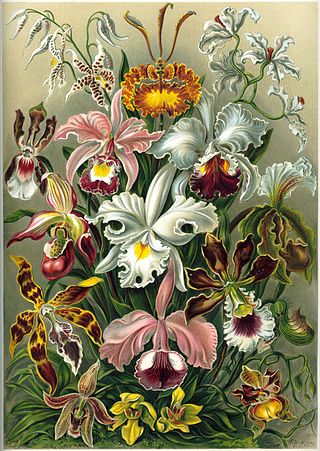
The taxonomy of the Orchidaceae (orchid family) has evolved slowly during the last 250 years, starting with Carl Linnaeus who in 1753 recognized eight genera. De Jussieu recognized the Orchidaceae as a separate family in his Genera Plantarum in 1789. Olof Swartz recognized 25 genera in 1800. Louis Claude Richard provided us in 1817 with the descriptive terminology of the orchids. (See External links below). The next step was taken in 1830-1840 by John Lindley, who recognized four subfamilies. He is generally recognized as the father of orchid taxonomy. The next important step was taken by George Bentham with a new classification, recognizing subtribes for the first time. This classification was first presented in a paper that Bentham read to the Royal Society in 1881. Then it was published in 1883 in the final volume of Genera Plantarum. The next great contributors were Pfitzer (1887), Schlechter (1926), Mansfeld (1937), Dressler and Dodson (1960), Garay (1960, 1972), Vermeulen (1966), again Dressler (1981). and Burns-Balogh and Funk (1986). Dressler's 1993 book had considerable influence on later work.

The Orchidoideae, or the orchidoid orchids, are a subfamily of the orchid family (Orchidaceae) that contains around 3630 species. Species typically have a single (monandrous), fertile anther which is erect and basitonic.

The Oncidiinae is a subtribe within the Orchidaceae that consists of a number of genera that are closely related.
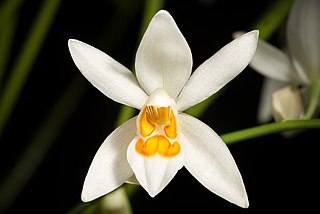
Arethuseae is a mid-sized tribe of orchids in the subfamily Epidendroideae. This tribe was initially categorized by John Lindley in 1840. Its largest subtribes are Arethusinae and Coelogyninae.

Disperis is a genus of plants in the orchid family, Orchidaceae. It has about 78 species. Most of the species are from tropical and southern Africa, as well as Indian Ocean islands. A few are native to the tropical or the warmer subtropical regions of Asia and Malesia.
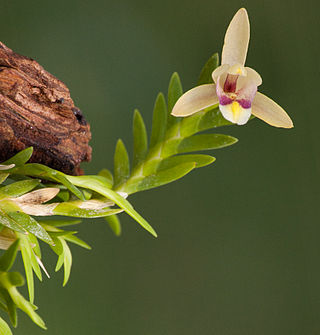
The Vandeae is a large monophyletic tribe within the family of orchids.

Ludisia (Lus.) is a genus of orchids that was thought to contain just one species, Ludisia discolor, commonly referred to as jewel orchid. A second species, Ludisia ravanii, from the Philippines, was described in 2013. Ludisia discolor is native to Southern China, Northeast India, Thailand, Vietnam, the Philippines, Malaysia, Indonesia and Myanmar, and often cultivated.
Jewel orchid is a common name which may refer to any orchid grown for its leaves rather than its flowers, including:
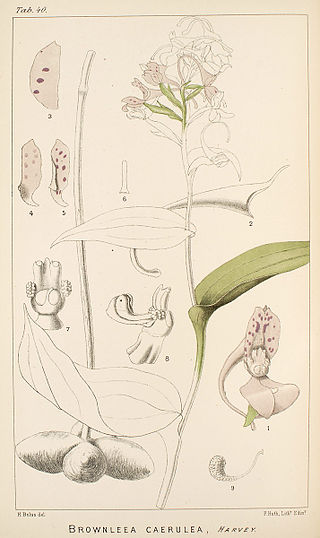
Brownleea is a genus of flowering plants from the family Orchidaceae native to Africa and Madagascar. Eight species are known.
- Brownleea coeruleaHarv. ex Lindl.
- Brownleea galpiniiBolus
- Brownleea graminicolaMcMurtry
- Brownleea macrocerasSond.
- Brownleea maculataP.J.Cribb
- Brownleea mulanjiensisH.P.Linder
- Brownleea parvifloraHarv. ex Lindl.
- Brownleea recurvataSond.
Vargasiella is a genus of flowering plants from the orchid family, Orchidaceae. It contains two species, both endemic to South America: It has been treated as the only genus in the subtribe Vargasiellinae, but more recently has been included in the subtribe Zygopetalinae.

Dendrobieae is a tribe in the subfamily Epidendroideae, in the family Orchidaceae. The Dendrobieae are mostly tropical, epiphytic orchids which contain pseudobulbs.

Diseae is an orchid tribe in the subfamily Orchidoideae. It was recognized in Genera Orchidacearum volume 2, which was published in 2001. It consisted of 12 genera in five subtribes. In molecular phylogenetic studies that were published after 1999, it was shown that Diseae is paraphyletic over the tribe Orchideae. In a classification of orchids that was published in 2015, Diseae was not recognized, but was instead placed in synonymy under Orchideae.

Spiranthinae is an orchid subtribe in the tribe Cranichideae.

Coryciinae is a subtribe of orchids that has been differently defined and placed in the two classification systems that are currently in use for orchids. Genera Orchidacearum, which is currently the definitive work on orchid taxonomy, delimits Coryciinae as consisting of five genera: Disperis, Evotella, Ceratandra, Pterygodium, and Corycium, and it places Coryciinae in the mostly African tribe Diseae, along with four other subtribes: Brownleeinae, Huttonaeinae, Disinae, and Satyriinae. The genera of Coryciinae are small to medium in size and the number of species in each genus is as follows: Disperis (78), Pterygodium (19), Corycium (15), Ceratandra (6), and Evotella (1).

The Coelogyninae are an orchid subtribe in the tribe Arethuseae.

Calypsoinae is an orchid subtribe in the tribe Epidendreae of subfamily Epidendroideae. It has previously been recognized as tribe Calypsoeae in the subfamily Epidendroideae.
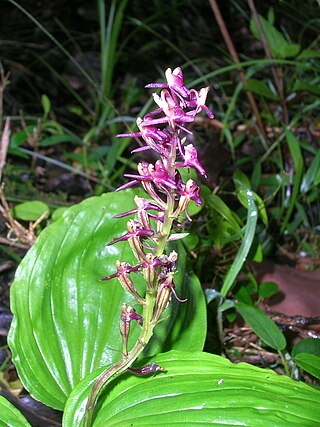
Malaxideae is an orchid tribe in the subfamily Epidendroideae.
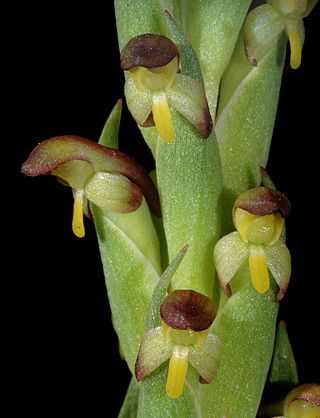
Disinae is a subtribe of orchids that has been differently defined and placed in the two classification systems that are currently in use for orchids. Genera Orchidacearum, which is currently the definitive work on orchid taxonomy, delimits Disinae as consisting of two closely related genera, Disa and Schizodium, and it places Disinae in the mostly African tribe Diseae, along with four other subtribes: Brownleeinae, Huttonaeinae, Coryciinae, and Satyriinae. In the classification for orchids that was published by Chase et alii in 2015, Schizodium was placed in synonymy under Disa, while Pachites and Huttonaea were transferred to Disinae. In Genera Orchidacearum, Pachites and Satyrium form the subtribe Satyriinae, and Huttonaea is the sole genus in the subtribe Huttonaeinae. The transfer of Pachites and Huttonaea to Disinae by Chase et alii (2015) was done with considerable doubt, and was based upon uncertainty about the relationships of these two genera. In 2009, a molecular phylogenetic study found only weak statistical support for a sister relationship between Huttonaea and Disa.

















